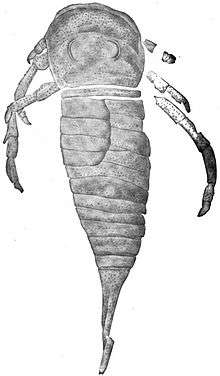Malcolm Laurie
Prof Malcolm Laurie FRSE FLS (27 February 1866 – 16 July 1932) was a Scottish zoologist[1] and palaeontologist.
Malcolm Laurie | |
|---|---|
| Born | 27 February 1866 |
| Died | 16 July 1932 (aged 70) |
| Nationality | Scottish |
| Alma mater | King's College, Cambridge |
| Known for | Arachnids, Scorpions |
| Scientific career | |
| Fields | Zoology, Palaeontology |
Biography

He was born in Brunstane House[2] south of Portobello, Edinburgh on 27 February 1866, the son of Simon Somerville Laurie and his wife, Catherine Ann Hibburd. He was educated at Edinburgh Academy 1876 to 1880. He studied Science, first at Edinburgh University then at Cambridge University where he graduated BA in 1889. He returned to Edinburgh for postgraduate studies and gained his doctorate (DSc) in 1894.[3][4]
On gaining his doctorate he received an immediate post as Professor of Zoology at St Mungo's College, Glasgow. In 1918 he returned to Edinburgh to lecture in Zoology at both the Royal College of Physicians of Edinburgh and the Royal College of Surgeons of Edinburgh.
In 1894 he had been elected a Fellow of the Royal Society of Edinburgh. His proposers were James Cossar Ewart, James Geikie, Sir William Turner and Ramsay Heatley Traquair. He was also a Fellow of the Linnean Society.[5]
He became examiner in zoology at the University of Glasgow in 1899.[6]
In 1907 he was living at "The Bloom", a villa on Canaan Lane in south-west Edinburgh.[7]
Family
His father was the educator Simon Somerville Laurie. He was the younger brother of chemist Arthur Pillans Laurie (1861-1949), both of whom were also Fellows of the Royal Society of Edinburgh.[1]
Reception
In a letter to Nature, three scientists wrote "The systematic position of Limulus has long been a vexed question, which no one can attempt to solve without consulting the work of Malcolm Laurie on the fossil Eurypterids."[8]
Works
Laurie published numerous papers on the arachnids, especially the scorpions.
- Elliot, George Francis Scott, Malcolm Laurie, J. Barclay Murdoch. Fauna, Flora and Geology of the Clyde Area. University of Glasgow Press, 1901.
References
- "Former Fellows of the Royal Society of Edinburgh 1783-2002" (PDF). Biographical Index, Part Two. Royal Society of Edinburgh. July 2006. Archived from the original (PDF) on 4 March 2016. Retrieved 8 October 2012.
- Edinburgh and Leith Post Office directory 1866-67
- Biographical Index of Former Fellows of the Royal Society of Edinburgh 1783–2002 (PDF). The Royal Society of Edinburgh. July 2006. ISBN 0-902-198-84-X. Archived from the original (PDF) on 4 March 2016. Retrieved 17 March 2017.
- Laurie, Malcolm (1894). Studies in arachnid morphology (Thesis). University of Edinburgh. hdl:1842/24058.
- Laurie, Malcolm (August 1896). "Further Notes on the Anatomy and Development of Scorpions, and their bearing on the Classification of the Order". Journal of Natural History. 18 (104): 121–133. doi:10.1080/00222939608680422.
- "News". The American Naturalist. 33 (394): 839–842. October 1889. doi:10.1086/277459. JSTOR 2454292.
- Transactions of the Natural History Society of Glasgow, 1907
- POCOCK R. I., F. A. BATHER & B. B. WOODWARD (16 November 1893). ""The Zoological Record" (Letters to Editor)" (PDF). Nature. 49 (1255): 53. doi:10.1038/049053a0.